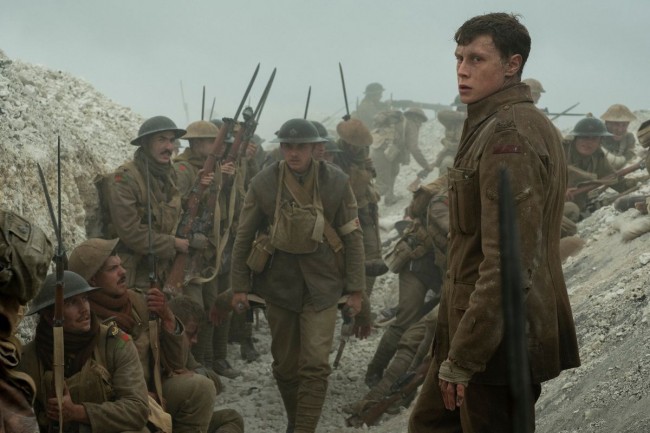Reviews Too Late: 1917
by wjw on January 25, 2020
 I’ve been wanting to see 1917 and various other recent movies, but life has been too hectic to see any entertainment that’s running on a theater’s schedule and not my own. But today was the first day in ages I haven’t been dashing from Pillar A to Post Z, so I decided to celebrate by spending a couple quiet hours in the cinema, entranced by someone else’s problems.
I’ve been wanting to see 1917 and various other recent movies, but life has been too hectic to see any entertainment that’s running on a theater’s schedule and not my own. But today was the first day in ages I haven’t been dashing from Pillar A to Post Z, so I decided to celebrate by spending a couple quiet hours in the cinema, entranced by someone else’s problems.
Since the movie’s been out for weeks I’ve had ample time to read the reviews, and I knew that it was based on First World War stories told to director Sam Mendes by his veteran grandfather, and that for some reason the movie was filmed as one two-hour-long take. The only other single-take feature I know of was Alfred Hitchcock’s Rope, after which even Hitchcock was forced to admit that filming in a single take surrenders much of the filmmaker’s vocabulary, and after viewing Rope I was inclined to agree with the sentiment.
So off I went. The plot concerns a pair of soldiers sent across no-man’s-land to find a colonel and tell him to call off a scheduled attack, because he’ll be leading his troops straight into an ambush. And then everything goes wrong. The two deal with booby traps, snipers, artillery fire, raging rapids, and a burning airplane dropping on their heads, which might seem a little excessive.
The first half of the film I found the single-take narration frustrating. Much of the action consisted of walk-and-talk scenes, in which the two soldiers advanced side-by-side while delivering exposition or trying to figure out how to avoid some deadly situation or other, or saving each other from a deadly situation they can’t avoid. Walk-and-talk scenes are delightful when delivering sparkling Aaron Sorkin dialogue on The West Wing, but on the Western Front, not so much.
During the dialogue scenes I kept longing for the standard establishing two-shot, closeup with dialogue, close-up reaction shot, which are tools for conveying drama in an effective way. Because all the walk-and-talks didn’t use the best tools available for dialogue, I felt alienated from the action.
But during the second half of the film, because of Plot, we are down to a single soldier desperately trying to finish the mission, and here Mendes’ single take really works, because we’re in only one soldier’s point of view, there’s very little dialogue happening, and there’s insane, vivid action taking place all the time. By the end of the film, my alienation had vanished and I was really caught up in the action.
There’s a good deal of teeth-grinding suspense as our heroes deal with one situation after another, but Mendes has learned that you can’t have a movie that’s nonstop action because the viewers will run out of energy before the movie does, and so there are some lovely quiet moments in the film, particularly near the end, as when the soldier finds himself in a forest, listening to another soldier singing “Poor Wayfaring Stranger.” That moment will break your heart.
And because long takes can lead to some surprising moments, when something unexpected happens and the camera just keeps running, you can have moments of complete serendipity, as when the soldier is running through a pack of charging Tommies and keeps accidentally bowling them, and himself, over. But the camera is running and so the soldier has to keep running too.
So 1917 is more than a great technical achievement, it’s a big movie with a lot of heart, for all that the contents are not always displayed to best advantage.
 I’ve been wanting to see 1917 and various other recent movies, but life has been too hectic to see any entertainment that’s running on a theater’s schedule and not my own. But today was the first day in ages I haven’t been dashing from Pillar A to Post Z, so I decided to celebrate by spending a couple quiet hours in the cinema, entranced by someone else’s problems.
I’ve been wanting to see 1917 and various other recent movies, but life has been too hectic to see any entertainment that’s running on a theater’s schedule and not my own. But today was the first day in ages I haven’t been dashing from Pillar A to Post Z, so I decided to celebrate by spending a couple quiet hours in the cinema, entranced by someone else’s problems.
I thought the opening half displayed well how worried and determined the one soldier was and how scared the more experienced soldier was because he had a better idea what they were getting into.
I’m still trying to carve out time to see this on the big screen.
Comments on this entry are closed.